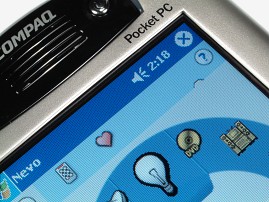|
...Continued from Page 2.
All the better to see you in the dark!
The LCD touchscreen on the iPAQ is certainly worth protecting. The new-technology 3.8" TFT (or “active matrix”) display supports 16-bit color – that’s 65,536 simultaneous colors – at 240 by 320 pixel resolution. TFT screens are the clearest and most vibrant type of LCD available, the same as those used on all modern laptop displays and desktop LCD monitors. TFT screens are brighter, crisper and suffer none of the smearing effects seen on the less expensive “passive matrix” variations, such as HPA and DSTN.

Click to enlarge. (125kb)
|
In addition, the iPAQ’s screen is of the special “transflective” variety. That means the screen can be fully backlit for use in the dark, or reflect back external illumination for use under bright lights and sunlight (similar to Nintendo’s Game Boy Advance). The screen’s backlight intensity can be adjusted manually, from practically “off” all the way up to a “turn it off, I can’t see the movie” level unmatched by current remotes. The unit even features an automatic power-saving mode that ramps brightness levels smoothly, depending on ambient lighting conditions: “not too bright” in complete darkness, “very bright” under moderate lighting levels, or “off” under extremely bright levels. This worked commendably well, although the adjustment takes several seconds to take effect after ambient levels have changed. It’s nifty to fade down the room’s lights and see the iPAQ follow suit.
Naturally, the iPAQ H3950 also features an auto power-off mode. The backlight can be disabled after 10 or 30 seconds, or 1, 2, 3, 4, or 5 minutes of inactivity. Once off, the backlight can be automatically reactivated whenever the screen is tapped. The whole system will shut off after 1 through 5 minutes of inactivity. After the iPAQ has completely powered down, the [Power] button or one of the four activity keys at the bottom must be pressed to turn it back on.
The touch-sensitive screen can be used with the included stylus, which stores securely in a small hole at the top of the case, or if you don’t mind a few fingerprints, using your finger. Some of the soft buttons are a tad small for the average-sized index finger, but the iPAQ did a commendable job of guessing what I wanted to press, even on things like the on-screen keyboard which divides the 2.5"-wide (6.4cm) display into 14 horizontal sections. Audible feedback is not provided for LCD buttons, although the Pocket PC operating system normally supports customizable tapping sounds.
It’s not all touchscreen!
Beneath the large and rather gorgeous touchscreen display are several hard buttons, comprised of four separate keys and an oval 5-way joystick. The four individual buttons normally access various Pocket PC applications, but are repurposed to device functions in the Nevo software. For instance, within Nevo the 5-way joystick is used for volume/channel, menu or transport controls. Other buttons include a [Power] button at the top, which turns the iPAQ on and off, plus a [Record] button on the left side that can be used to record voice memos. A headphone jack is also included, but as the Nevo has no real sound capabilities we won’t get into that.
| 
